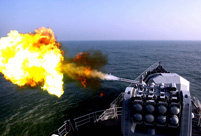

BEIJING, April 6 -- While supply-side theory is dominating China's economic policies, a veteran economist has argued that infrastructure investment and other measures on the demand side are still necessary to arrest the slowdown.
Policymakers should coordinate policies to propel reform rather than counting on just one side, Yu Yongding with the Chinese Academy of Social Sciences said in an article published on Wednesday in the China Securities Journal.
"China is not facing a choice between Keynesian stimulus or supply-side reform, but rather a challenge in balancing the two," said Yu, a former member of the central bank's Monetary Policy Committee and president of the China Society of World Economics.
Supply-side structural reform was proposed in a tone-setting economic conference in November as a solution to China's economic woes as demand-side support, generally known as stimulus, has been considered less effective.
Yu's opinion comes as a response to a rising economic point of view that the country should focus on restructuring even if it means sacrificing GDP growth.
"While slower growth is unavoidable because of adjustment, there is a limit to how low a growth rate China can accept," he said.
That threshold may not be far off, according to the economist, as the Chinese economy expanded just 6.9 percent year on year in 2015, the weakest reading in around quarter of a century.
China remains gripped by deflation and faces impacts from sluggish property investment. Despite mildly-rising consumer prices, the producer price index, which measures wholesale inflation, dropped for the 48th consecutive month in February. Beset by a piling inventory of unsold homes, property developers have markedly slashed capital inflow into the property sector with total investment growth cooling to 1 percent in 2015.
There is good reason to believe the economic growth will continue to decline this year, Yu said.
"In order to avoid a hard landing that would make structural adjustment extremely difficult to implement... another stimulus package that increases aggregate demand through infrastructure investment is needed," he went on. "Given that China's fiscal position remains relatively strong, such a policy is entirely feasible."
Yu said the new stimulus package should be designed and implemented with much more care than the previous 4-trillion-yuan (nearly 620 billion U.S. dollars) package that China introduced in 2008.
"With the right investments, China can improve its economic structure, while helping to eliminate overcapacity," Yu said.
He advised the government use bonds to finance projects, instead of bank credit, to prevent asset bubbles. The central bank should adjust monetary policy to lower government-bond yields and remove the shackles from the renminbi exchange rate.
"Structural adjustment remains absolutely critical to China's future, and the country should be prepared to bear the pain of that process," he added.
 The evolution of J-10 fighter
The evolution of J-10 fighter Top 10 Asian beauties in 2016
Top 10 Asian beauties in 2016 Train rides through blossoms
Train rides through blossoms HD pictures of battleships of PLA Navy
HD pictures of battleships of PLA Navy East Sea Fleet conducts combat drills
East Sea Fleet conducts combat drills Sophie Marceau goes square dancing in Guangzhou
Sophie Marceau goes square dancing in Guangzhou Police officers learn Wing Chun in E. China
Police officers learn Wing Chun in E. China Charming models compete in super model contest in Beijing
Charming models compete in super model contest in Beijing Beauties wearing Tang dynasty costume pick tea leaves
Beauties wearing Tang dynasty costume pick tea leaves Top 20 hottest women in the world in 2014
Top 20 hottest women in the world in 2014 Top 10 hardest languages to learn
Top 10 hardest languages to learn 10 Chinese female stars with most beautiful faces
10 Chinese female stars with most beautiful faces China’s Top 10 Unique Bridges, Highways and Roads
China’s Top 10 Unique Bridges, Highways and Roads Racing to the self-driving car
Racing to the self-driving car Consensus needed to impose pressure on Pyongyang
Consensus needed to impose pressure on Pyongyang Suu Kyi meeting heralds good beginning for Sino-Myanmar ties
Suu Kyi meeting heralds good beginning for Sino-Myanmar ties Chinese tourists walk in footsteps of Marx and Lenin in UK, Russia
Chinese tourists walk in footsteps of Marx and Lenin in UK, RussiaDay|Week